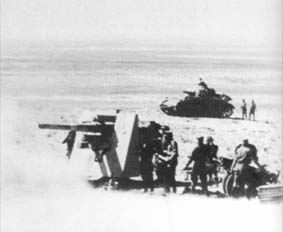|
The 88mm FLAK (FlugzeugAbwehrKannone) was originally intended exclusively for anti-aircraft defense. But at its very first use by the Legion Kondor volunteer unit in the Spanish Civil War, the Flak gun was also used on the front lines to attack bunkers and pinpoint targets with anti-tank shells, or against enemy troops, using time-fuze shells with high exploding points. The 88mm Flak gun stood out on all fronts because of its mobility, rapid rate of fire (15 to 25 rounds per minute, depending on the crew's level of training) and number of possible uses.
In Germany it was used to protect important military or supply sites from air attack. At the fronts, the Flak guns were assigned other combat tasks such as antitank use, attacking bunkers, supporting troops under pressure in ground combat, and on the coasts they they even fired on sea targets and fought off attempts to land.
In the Western campaign in May 1940 the 88mm Flak was the only weapon that penetrated the heavy French tank armor. Great demands were made of Flak units, which accompanied the Panzer troops on their fast advances and received alternating air-protection and ground-combat assignments. That often meant moving their positions two or three times a day, including the work of trenching. Very often in this action, motorized units of the army had to be caught and passed, so as to guarantee gap-free protection against air attacks along the advance route. Single 88mm Flak guns were also used by so-called Flak battle troups to wipe out enemy points of resistance.
The Flak played an outstanding part in penetrating the Maginot line in 1940. In this action antitank shells were fired to put the crews of many concrete bunkers and armored turrets out of action. The best range for firing on bunkers proved to be 600 to 2000 meters.
Since the anti-tank units could scarcely hold their own against the Russian T34 tanks with their 37mm Pak guns (known to the troops as "army door-knockers" because of their poor penetrating power), 88mm Flak guns had to be used again and again, often as the only effective weapon available.
Later in the course of the war, well-trained and experienced Flak units were transferred more and more often from home defence to the fronts. They were often replaced by schoolboys or Hitler Youth members as Luftwaffe helpers (Flak aides), or by young people chosen by the SS from the occupied territories in the east.
|
